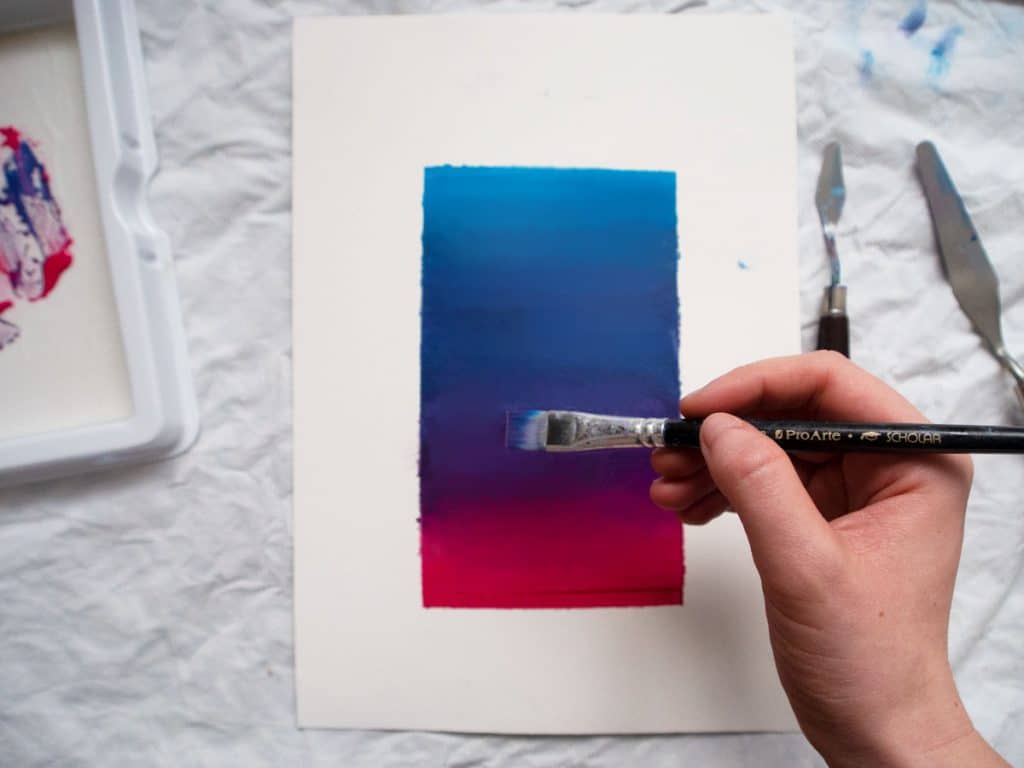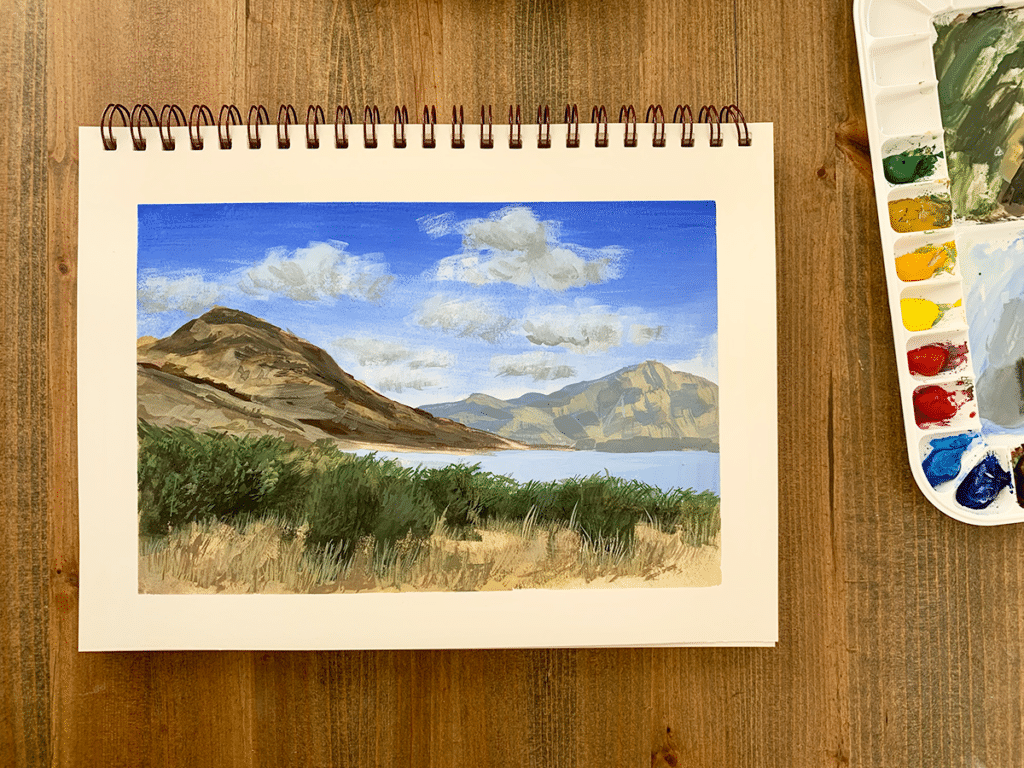Two popular painting mediums that share some similarities, but also have many differences are gouache and acrylic paint. Their differences make them suited to different painting styles and requirements.
In this guide, find a comparison of gouache vs acrylic, including all of their differences in properties and performance and the benefits of using each medium. We compare attributes like surface finish, lightfastness, texture, techniques and supplies needed.
Disclaimer: Fine Art Tutorials is a reader supported site. When you make purchases through links on this site, we may earn a small commission at no extra cost to you.
What are they made from?

Gouache and acrylic paint are both water-based paints that consist of a binder and a pigment. However, the binder that is used as a vehicle to carry the pigment differs between the two paints.
The binder in acrylic paint is a type of polymer resin. When the water evaporates, the binder forms an impermeable film.
Gouache, on the other hand, is made with pigment and a binder of gum arabic. The pigment content is usually much more concentrated in gouache paints compared to watercolour paints and some brands will add extra ingredients to the paint mixture, like chalk or titanium white to make the paint appear more opaque.
Are the two mediums workable once dry?
Another important difference between gouache and acrylic, is the fact that acrylic paint is completely waterproof once dry and gouache paint can be reactivated.
Gouache behaves in a similar way to watercolour, you can lift paint from paper with water, once the paint layer has dried. This means that paint layers, are to some extent workable once they have already dried. However, artists can still layer colours on top of dried paint layers without them blending into one another.

Acrylic paint is not workable once dry. It forms an impermeable layer which won’t reactivate with water, making the surface waterproof. However, artists can still mix colours on the canvas or use a wet brush to blend colours together before they are completely dry.
What is the surface finish of gouache vs acrylic?

Gouache is a matte medium, when dry it appears as a completely matte, flat, solid colour. Acrylic paint is usually glossier when dry, however this can be manipulated by using a matte medium or an acrylic gloss medium.
What is the texture of gouache vs acrylic?
The texture of gouache is fairly runny, smooth and creamy. When water is added to the paint, it lowers the viscosity and makes it behave more like watercolour.

The texture of acrylic paint depends on the type of acrylic paint you choose to get. For instance, heavy body acrylic is thick like oil paint. It will hold its texture on the canvas and you can use a palette knife to paste it onto a surface. With heavy body acrylics, you can create thick, impasto textures and impressionist effects.
Soft body acrylics are more fluid in texture; they have self levelling properties and are much better for painting fine details.
Fluid acrylics are less viscous and transparent and are therefore perfect for creating glazes.
What is the drying time of gouache vs acrylic?
When it comes to drying time, gouache dries faster than acrylic. When using acrylic paint applied thinly to the paper, it should dry in around 30 minutes.
However, thicker acrylic paints will take longer to dry and harden all the way through. To slow the drying time of acrylics, it’s possible to delay drying by hours by adding an acrylic paint medium. Alternatively, get Open Acrylics by Golden, that take several hours to dry. This means you can blend paint for longer on the canvas.
Lightfastness of gouache and acrylic
The lightfastness, or permanence of pigments used by different brands of gouache and acrylic paints vary between between brands. Paint brands that describe themselves as being professional grade, will make lightfast colours.
The brands of gouache that make tubes with excellent lightfast ratings are Schmincke, Holbein, M. Graham, Winsor & Newton and Da Vinci. Check the permanence ratings on the tubes of the paint for more information and make sure to only use permanent pigments for artworks that you want to be archival and stand the test of time.
Professional brands of acrylic paints like Golden and Old Holland offer excellent lightfastness. Student grade brands like Daler Rowney System 3 do not have excellent lightfast ratings and are therefore unsuitable for creating archival artworks as the colours may fade over time.
What kinds of surfaces can you paint on with gouache vs acrylic?
Gouache is a runny and fairly brittle medium that needs to be painted on an absorbent surface like paper, in order for it to bind properly. Any type of surface used for watercolour painting can also be used for gouache. Hot pressed papers are an excellent choice for those who want their colours to appear brighter, details to appear more pronounced and don’t need an ultra absorbent paper for creating heavy washes. If you plan to use your gouache paints more like watercolour, with lots of layers of washes, cold pressed paper would be a good choice.
Acrylic paint is more versatile in the sense that artists can paint with it on a variety of different surfaces. Canvas, wooden panel and paper are all suitable surfaces for acrylic painting. When dry, acrylic polymers create a firm, but flexible film. This makes the medium especially resistant to cracking when used on a flexible surface like canvas.
What techniques can you use with acrylic vs gouache?

The two mediums share essential techniques, however, in practice the techniques used with acrylic paint and gouache paint look quite different. With acrylic, use the impasto technique to create thick texture by adding a medium like a thickening gel to create sculptural effects. On the other hand, you can use acrylic to create fine glazes of transparent colour, that alter the tones and hues of previous layers by adding a glazing medium to soft body paint. You can also pour acrylic paint, airbrush it, blend it, create underpaintings—the possibilities are endless!

Gouache is a flat paint, so techniques used with this medium will involve more subtlety in terms of layering colours. Try the dry brush technique to create the appearance of texture. This technique adding colour to the brush, then dabbing the brush on a paper towel so it soaks up excess moisture. This leaves you with a relatively dry brush that you can use to create the appearance of broken lines, which can be especially useful when landscape painting, for creating the appearance of textures like jagged rocks, tree bark or leaves quickly.
Do you need different brushes for acrylic and gouache?

The best gouache brushes are soft, absorbent and have a spring. Kolinsky sable brushes, which are also used for watercolour also work well to apply gouache to paper. Soft synthetic brushes like the Escoda Perla, or the Escoda Prado Tame are also excellent choices for gouache painting. Brushes with stiff bristles may be more unsuitable for gouache painting as they are less absorbent, do not spread low viscosity paint as easily and damage paper fibres.
However, natural hair brushes like sable, should not be used with acrylic as the resins in the paint can damage fibres. Instead, stick to using synthetic brushes. You can use any type of synthetic brush with acrylic paint, from soft bristles that emulate kolinsky sable, to stiff bristles that act like hog. Ultra soft bristles, advertised as synthetic squirrel hair brushes, may not move the thicker paint effectively, however. As a rule of thumb, use stiff synthetic bristle brushes like the Princeton Catalyst Polytip brushes with thick, heavy body paint and soft brushes like Escoda Perla with fluid acrylic paint.
What are the best uses for these mediums?
Gouache dries to a matte finish and many brands of gouache are not lightfast. For graphic artists and illustrators working with designers gouache that has a tendency to fade over time, the best use case is for illustrations that they plan to scan in.
Many artists use gouache for sketchbook work, or for creating studies that they later use as references to create larger final pieces in oil or acrylic.
However, for artists using lightfast gouache paints such as M. Graham gouache paints, gouache can be treated like an opaque watercolour for final pieces on paper. Create opaque layers and layer lighter colours on top of darker colours for tints and highlights, but use this method with watercolour techniques such as washes and dry brushing.
Many artists love using gouache for plein air painting. It’s as easy to clean up as watercolour, but its opaque nature gives the flexibility to layer highlights over midtones. This provides an easy painting experience when out and about.
Acrylic on the other hand is a versatile medium that can be thickened to create texture, or thinned to create transparent glazes. The lightfastness of professional brands paired with the waterproof film it creates when dry, makes this a fantastic archival medium. Paint with acrylic on large canvases with a palette knife, or on acrylic paper with a soft brush. Overall, acrylic is a great choice of medium for artists who want to create final pieces, with a paint that dries quickly but has the permanence of oil.
What is acrylic gouache?
Acrylic gouache is a type of paint that has attributes of both acrylic and gouache paint. The paint dries quickly, has a matte surface finish, has a similar opacity, texture and quality to gouache, but dries to a waterproof film. This means that you can work with completely separate colour layers, but cannot use lifting or rewetting techniques with the medium. Acrylic gouache would be suitable for someone who wants their paint to dry to a waterproof film, if they are painting en plein air and concerned about a water soluble paint getting damaged, for instance. The paint layer of acrylic gouache also has more flexibility than regular gouache and can be painted on surfaces like canvas and panel. In conclusion, if you want to achieve the look of gouache, with the versatility of acrylic, it’s likely that acrylic gouache would suit your practice.
The best brand of acrylic gouache is Holbein. The paints are vibrant, lightfast, pigment rich and are considered professional quality.
Finally
Gouache and acrylic are two mediums with a multitude of different attributes and properties. Depending on your painting style, you may find yourself drawn to one or the other. Both mediums are capable of creating stunning pieces. With a little practice, you can use them interchangeably to achieve the look you desire. But if you want to find that perfect balance between the two mediums, why not try using acrylic gouache?

